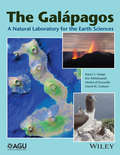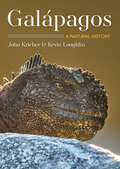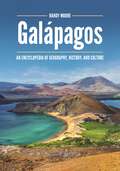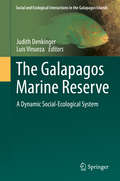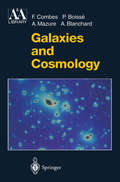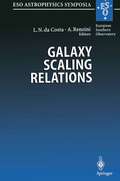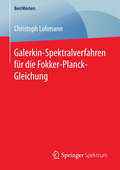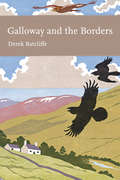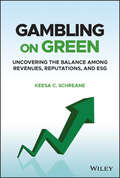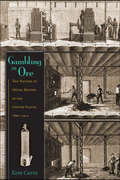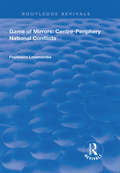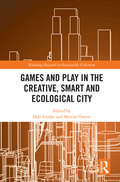- Table View
- List View
The Gaia Hypothesis: Science on a Pagan Planet (science.culture)
by Michael RuseIn 1965 English scientist James Lovelock had a flash of insight: the Earth is not just teeming with life; the Earth, in some sense, is life. He mulled this revolutionary idea over for several years, first with his close friend the novelist William Golding, and then in an extensive collaboration with the American scientist Lynn Margulis. In the early 1970s, he finally went public with the Gaia hypothesis, the idea that everything happens for an end: the good of planet Earth. Lovelock and Margulis were scorned by professional scientists, but the general public enthusiastically embraced Lovelock and his hypothesis. People joined Gaia groups; churches had Gaia services, sometimes with new music written especially for the occasion. There was a Gaia atlas, Gaia gardening, Gaia herbs, Gaia retreats, Gaia networking, and much more. And the range of enthusiasts was—and still is—broad. In The Gaia Hypothesis, philosopher Michael Ruse, with his characteristic clarity and wit, uses Gaia and its history, its supporters and detractors, to illuminate the nature of science itself. Gaia emerged in the 1960s, a decade when authority was questioned and status and dignity stood for nothing, but its story is much older. Ruse traces Gaia’s connection to Plato and a long history of goal-directed and holistic—or organicist—thinking and explains why Lovelock and Margulis’s peers rejected it as pseudoscience. But Ruse also shows why the project was a success. He argues that Lovelock and Margulis should be commended for giving philosophy firm scientific basis and for provoking important scientific discussion about the world as a whole, its homeostasis or—in this age of global environmental uncertainty—its lack thereof. Melding the world of science and technology with the world of feeling, mysticism, and religion, The Gaia Hypothesis will appeal to a broad range of readers, from students and scholars of the history and philosophy of science to anyone interested in New Age culture.
The Gaia Hypothesis: Science on a Pagan Planet (science.culture)
by Michael RuseIn 1965 English scientist James Lovelock had a flash of insight: the Earth is not just teeming with life; the Earth, in some sense, is life. He mulled this revolutionary idea over for several years, first with his close friend the novelist William Golding, and then in an extensive collaboration with the American scientist Lynn Margulis. In the early 1970s, he finally went public with the Gaia hypothesis, the idea that everything happens for an end: the good of planet Earth. Lovelock and Margulis were scorned by professional scientists, but the general public enthusiastically embraced Lovelock and his hypothesis. People joined Gaia groups; churches had Gaia services, sometimes with new music written especially for the occasion. There was a Gaia atlas, Gaia gardening, Gaia herbs, Gaia retreats, Gaia networking, and much more. And the range of enthusiasts was—and still is—broad. In The Gaia Hypothesis, philosopher Michael Ruse, with his characteristic clarity and wit, uses Gaia and its history, its supporters and detractors, to illuminate the nature of science itself. Gaia emerged in the 1960s, a decade when authority was questioned and status and dignity stood for nothing, but its story is much older. Ruse traces Gaia’s connection to Plato and a long history of goal-directed and holistic—or organicist—thinking and explains why Lovelock and Margulis’s peers rejected it as pseudoscience. But Ruse also shows why the project was a success. He argues that Lovelock and Margulis should be commended for giving philosophy firm scientific basis and for provoking important scientific discussion about the world as a whole, its homeostasis or—in this age of global environmental uncertainty—its lack thereof. Melding the world of science and technology with the world of feeling, mysticism, and religion, The Gaia Hypothesis will appeal to a broad range of readers, from students and scholars of the history and philosophy of science to anyone interested in New Age culture.
Gaia, Psyche and Deep Ecology: Navigating Climate Change in the Anthropocene
by Andrew FellowsWinner of the Scientific & Medical Network Book Prize 2019! In Gaia, Psyche and Deep Ecology: Navigating Climate Change in the Anthropocene, Andrew Fellows uniquely connects Earth systems, Jungian and philosophical approaches to the existential threats that we face today. He elucidates the psychological basis of our dysfunctional relationship with nature, thereby offering a coherent framework for transforming this in our personal and professional lives. Demonstrating the imperative for new ideas that transcend the status quo, Fellows tackles unprecedented 21st century challenges such as climate change through his interdisciplinary approach. Fellows proposes a worldview, informed by depth psychology, which radically contradicts the prevailing shibboleths of unlimited economic growth, dominion over outer nature and negation of our inner nature. To accommodate a broad readership, he first introduces the Anthropocene and sufficient basics of systems dynamics, Gaia theory and analytical psychology before exploring the mind-matter conundrum. He then correlates the structure, dynamics, contents and pathology of Gaia and of psyche, critiques the Western Zeitgeist as midlife crisis and establishes parallels between deep ecology and psychological individuation. This ground-breaking synthesis of Gaia theory, analytical psychology and deep ecology reveals synergies which show how we can, and why we must, relinquish anthropocentrism in order to survive sustainably as equals in and with the natural world. Combining Jungian theory with other cutting-edge disciplines to inform, inspire and heal, this book is essential reading not only for Jungian analysts, students and scholars, but for all—including professionals in Earth systems science, environmental philosophy and ecopsychology—who realise that ‘business as usual’ is no longer an option.
Gaia, Psyche and Deep Ecology: Navigating Climate Change in the Anthropocene
by Andrew FellowsWinner of the Scientific & Medical Network Book Prize 2019! In Gaia, Psyche and Deep Ecology: Navigating Climate Change in the Anthropocene, Andrew Fellows uniquely connects Earth systems, Jungian and philosophical approaches to the existential threats that we face today. He elucidates the psychological basis of our dysfunctional relationship with nature, thereby offering a coherent framework for transforming this in our personal and professional lives. Demonstrating the imperative for new ideas that transcend the status quo, Fellows tackles unprecedented 21st century challenges such as climate change through his interdisciplinary approach. Fellows proposes a worldview, informed by depth psychology, which radically contradicts the prevailing shibboleths of unlimited economic growth, dominion over outer nature and negation of our inner nature. To accommodate a broad readership, he first introduces the Anthropocene and sufficient basics of systems dynamics, Gaia theory and analytical psychology before exploring the mind-matter conundrum. He then correlates the structure, dynamics, contents and pathology of Gaia and of psyche, critiques the Western Zeitgeist as midlife crisis and establishes parallels between deep ecology and psychological individuation. This ground-breaking synthesis of Gaia theory, analytical psychology and deep ecology reveals synergies which show how we can, and why we must, relinquish anthropocentrism in order to survive sustainably as equals in and with the natural world. Combining Jungian theory with other cutting-edge disciplines to inform, inspire and heal, this book is essential reading not only for Jungian analysts, students and scholars, but for all—including professionals in Earth systems science, environmental philosophy and ecopsychology—who realise that ‘business as usual’ is no longer an option.
Gaia’s Body: Toward a Physiology of Earth (Copernicus Ser.)
by Tyler VolkIf the biosphere really is a single coherent system, then it must have something like a physiology. It must have systems and processes that perform living functions. In Gaia's Body, Tyler Volk describes the environment that enables the biosphere to exist, various ways of looking at its "anatomy" and "physiology", the major biogeographical regions such as rainforests, deserts, and tundra, the major substances the biosphere is made of, and the chemical cycles that keep it in balance. He then looks at the question of whether there are any long-term trends in the earth's evolution, and examines the role of humanity in Gaia's past and future. Both adherents and sceptics have often been concerned that Gaia theory contains too much goddess and too few verifiable hypotheses. This is the book that describes, for scientists, students, and lay readers alike, the theory's firm basis in science.
The Galactic Interstellar Medium: Saas-Fee Advanced Course 21. Lecture Notes 1991. Swiss Society for Astrophysics and Astronomy (Saas-Fee Advanced Course #21)
by W.B. Burton B.G. Elmegreen R. GenzelThe previous Saas-Fee Advanced Course dedicated to the interstellar medium took place in 1972. The tremendous scientific advances that have occurred in this field since then, in particular owing to the availabihty of receivers working at completely unexplored wavelength bands, fuUy justified a new set of lectures. As a consequence, the members of the Swiss Society for Astrophysics and As tronomy voted that "The Galactic Interstellar Medium" should be the subject of the 1991 course. The 21st Saas Fee Advanced Course took place in Les Diablerets from 18 to 23 March 1991, gathering together about 80 participants from all over the world, but mostly from Europe. According to a rule that has proved to lead to success, but also to chal lenge the lecturers' energy, the format of a Saas-Fee Advanced Course consists traditionally of 28 lectures of 45 minutes which take place in the morning and late afternoon, leaving ample time for discussions, self-study, hiking or skiing. Despite the inordinate work load imposed, this year's lecturers felt that the subject was sufficiently dense to increase the lecture time by 1/3! This proved judicious and left more time for questions and discussions during the lectures.
The Galapagos: A Natural Laboratory for the Earth Sciences (Geophysical Monograph Series #204)
by Karen S. Harpp Eric Mittelstaedt Noémi D’Ozouville David W. GrahamThe Galápagos Islands are renown for their unique flora and fauna, inspiring Charles Darwin in the elaboration of his theory of evolution. Yet in his Voyage of the Beagle, published in 1839, Darwin also remarked on the fascinating geology and volcanic origin of these enchanted Islands. Since then, the Galápagos continue to provide scientists with inspiration and invaluable information about ocean island formation and evolution, mantle plumes, and the deep Earth. Motivated by an interdisciplinary Chapman Conference held in the Islands, this AGU volume provides cross-disciplinary collection of recent research into the origin and nature of ocean islands, from their deepest roots in Earth's mantle, to volcanism, surface processes, and the interface between geology and biodiversity. Volume highlights include: Case studies in biogeographical, hydrological, and chronological perspective Understanding the connection between geological processes and biodiversity Synthesis of decades of interdisciplinary research in physical processes from surface to deep interior of the earth In-depth discussion of the concept of the island acting as a natural laboratory for earth scientists Integrated understanding of the Galápagos region from a geological perspective Collectively, The Galápagos presents case studies illustrating the Galápagos Archipelago as a dynamic natural laboratory for the earth sciences. This book would be of special interest to a multidisciplinary audience in earth sciences, including petrologists, volcanologists, geochronologists, geochemists, and geobiologists.
The Galapagos: A Natural Laboratory for the Earth Sciences (Geophysical Monograph Series #204)
by Karen S. Harpp Eric Mittelstaedt Noémi D'Ozouville David W. GrahamThe Galápagos Islands are renown for their unique flora and fauna, inspiring Charles Darwin in the elaboration of his theory of evolution. Yet in his Voyage of the Beagle, published in 1839, Darwin also remarked on the fascinating geology and volcanic origin of these enchanted Islands. Since then, the Galápagos continue to provide scientists with inspiration and invaluable information about ocean island formation and evolution, mantle plumes, and the deep Earth. Motivated by an interdisciplinary Chapman Conference held in the Islands, this AGU volume provides cross-disciplinary collection of recent research into the origin and nature of ocean islands, from their deepest roots in Earth's mantle, to volcanism, surface processes, and the interface between geology and biodiversity. Volume highlights include: Case studies in biogeographical, hydrological, and chronological perspective Understanding the connection between geological processes and biodiversity Synthesis of decades of interdisciplinary research in physical processes from surface to deep interior of the earth In-depth discussion of the concept of the island acting as a natural laboratory for earth scientists Integrated understanding of the Galápagos region from a geological perspective Collectively, The Galápagos presents case studies illustrating the Galápagos Archipelago as a dynamic natural laboratory for the earth sciences. This book would be of special interest to a multidisciplinary audience in earth sciences, including petrologists, volcanologists, geochronologists, geochemists, and geobiologists.
Galápagos: A Natural History Second Edition
by John C. Kricher Kevin LoughlinA richly illustrated nature tour of Galápagos—now expanded, thoroughly updated, and with more than 650 color photographsGalápagos is a comprehensive, up-to-date, and profusely illustrated natural history of this spectacular archipelago. Offering much more information than identification guides, the book provides detailed accounts and more than 650 color photographs of the islands’ habitats, marine life, reptiles, birds, mammals, and plants, making the book a virtual nature tour of Galápagos.Galápagos experts John Kricher and Kevin Loughlin have thoroughly revised the original text, bringing all the taxonomy up to date and adding a wealth of new information. Individual chapters cover geology, ecology, human history, Darwin’s finches and how Darwin came to his theory of natural selection from his visit to the islands, Galápagos tortoises, marine and land iguanas, mammals, seabirds, landbirds, marine life, and conservation challenges and initiatives. The concluding chapter covers each of the individual islands, including landing sites, unique plant and animal species, and points of interest, and serves as a wonderful guide for visitors as they move from island to island or plan a trip to Galápagos.With its combination of rich text and splendid photos, Galápagos is essential reading for the ecotraveler and nature enthusiast alike.Now with more than 650 color photographs, showing habitats, geology, marine life, and all the commonly encountered reptiles, birds, mammals, and plantsFeatures a detailed island-by-island guide, including landing sites and what visitors can expectEssential reading for the ecotraveler and nature enthusiast
Galápagos: A Natural History Second Edition
by John C. Kricher Kevin LoughlinA richly illustrated nature tour of Galápagos—now expanded, thoroughly updated, and with more than 650 color photographsGalápagos is a comprehensive, up-to-date, and profusely illustrated natural history of this spectacular archipelago. Offering much more information than identification guides, the book provides detailed accounts and more than 650 color photographs of the islands’ habitats, marine life, reptiles, birds, mammals, and plants, making the book a virtual nature tour of Galápagos.Galápagos experts John Kricher and Kevin Loughlin have thoroughly revised the original text, bringing all the taxonomy up to date and adding a wealth of new information. Individual chapters cover geology, ecology, human history, Darwin’s finches and how Darwin came to his theory of natural selection from his visit to the islands, Galápagos tortoises, marine and land iguanas, mammals, seabirds, landbirds, marine life, and conservation challenges and initiatives. The concluding chapter covers each of the individual islands, including landing sites, unique plant and animal species, and points of interest, and serves as a wonderful guide for visitors as they move from island to island or plan a trip to Galápagos.With its combination of rich text and splendid photos, Galápagos is essential reading for the ecotraveler and nature enthusiast alike.Now with more than 650 color photographs, showing habitats, geology, marine life, and all the commonly encountered reptiles, birds, mammals, and plantsFeatures a detailed island-by-island guide, including landing sites and what visitors can expectEssential reading for the ecotraveler and nature enthusiast
Galápagos: An Encyclopedia of Geography, History, and Culture
by Randy MooreThis encyclopedia provides readers with a comprehensive look at the Galápagos Islands, from the wildlife and scientists that made them famous to the challenges and issues the islands face today.In the mid-1800s, the Galápagos Islands served as Charles Darwin's playground, a volcanic archipelago where he famously worked on his theories of evolution and natural selection. But who actually discovered the islands? Why didn't any country claim them for more than 200 years? And is ecotourism hurting or helping these mysterious islands?This volume explores the history, science, and culture of the Galápagos Islands. A Preface, Introduction, Chronology, and Galápagos at a Glance primer introduce readers to the islands that are so famously associated with Charles Darwin. Twelve thematic essays allow readers to explore such topics as evolution, the geology of the islands, invasive species, and tourism in depth. Topical entries follow, covering key individuals and organizations as well as other important concepts and ideas.Thirteen primary document excerpts allow readers to study firsthand accounts from explorers and visitors to the islands. Appendices, a glossary, a bibliography, and sidebars round out the text. Students of history, geography, and science will find this volume informative, while general readers will be intrigued to learn about these unique islands.
Galápagos: An Encyclopedia of Geography, History, and Culture
by Randy MooreThis encyclopedia provides readers with a comprehensive look at the Galápagos Islands, from the wildlife and scientists that made them famous to the challenges and issues the islands face today.In the mid-1800s, the Galápagos Islands served as Charles Darwin's playground, a volcanic archipelago where he famously worked on his theories of evolution and natural selection. But who actually discovered the islands? Why didn't any country claim them for more than 200 years? And is ecotourism hurting or helping these mysterious islands?This volume explores the history, science, and culture of the Galápagos Islands. A Preface, Introduction, Chronology, and Galápagos at a Glance primer introduce readers to the islands that are so famously associated with Charles Darwin. Twelve thematic essays allow readers to explore such topics as evolution, the geology of the islands, invasive species, and tourism in depth. Topical entries follow, covering key individuals and organizations as well as other important concepts and ideas.Thirteen primary document excerpts allow readers to study firsthand accounts from explorers and visitors to the islands. Appendices, a glossary, a bibliography, and sidebars round out the text. Students of history, geography, and science will find this volume informative, while general readers will be intrigued to learn about these unique islands.
Galápagos: Life in Motion
by Walter Perez Michael WeisbergA lavish photographic celebration that captures the fascinating behaviors of land and sea animals in the Galápagos IslandsThe Galápagos Islands are home to an amazing variety of iconic creatures, from Giant Tortoises, Galápagos Sea Lions, Galápagos Penguins, and Ghost Crabs to Darwin’s finches, the Blue-footed Booby, and Hummingbird Moths. But how precisely do these animals manage to survive on—and in the waters around—their desert-like volcanic islands, where fresh water is always scarce, food is often hard to come by, and finding a good mate is a challenge because animal populations are so small? In this stunning large-format book, Galápagos experts Walter Perez and Michael Weisberg present an unprecedented photographic account of the remarkable survival behaviors of these beautiful and unique animals. With more than 200 detailed, close-up photographs, the book captures Galápagos animals in action as they feed, play, fight, court, mate, build nests, give birth, raise their young, and cooperate and clash with other species.Watch male Marine Iguanas fight over territory and females; see frigatebirds steal food and nesting materials from other birds; witness the courtship dance of a pair of Blue-footed Boobies; go underwater to glimpse a Galápagos Sea Lion pup playing with its mother; and observe a baby Pacific Green Turtle enter the water for the first time. These and dozens of other unforgettable scenes are all vividly captured here—including many moments that even experienced Galápagos observers may never be lucky enough to see in person.Complete with a brief text that provides essential context, this book will be cherished by Galápagos visitors and anyone else who wants to see incredible animals on the move.
The Galapagos Marine Reserve: A Dynamic Social-Ecological System (Social and Ecological Interactions in the Galapagos Islands)
by Judith Denkinger Luis VinuezaThis book focuses on how marine systems respond to natural and anthropogenic perturbations (ENSO, overfishing, pollution, tourism, invasive species, climate-change). Authors explain in their chapters how this information can guide management and conservation actions to help orient and better manage, restore and sustain the ecosystems services and goods that are derived from the ocean, while considering the complex issues that affect the delicate nature of the Islands. This book will contribute to a new understanding of the Galapagos Islands and marine ecosystems.
Galaxies and Cosmology (Astronomy and Astrophysics Library)
by Francoise Combes Patrick Boisse Alain Mazure Alain BlanchardUnique in its breadth of coverage and level of presentation, this textbook examines the nature of galaxies, extragalactic objects, the large-scale structure of the Universe, and cosmology more closely than general textbooks on astronomy, while still remaining comprehensible for advanced undergraduate students. One or several chapters are devoted to the following: the formation, classification and morphology of galaxies; the interactions between galaxies; the galactic interstellar medium; galactic kinematics; elliptical, spiral, and barred spiral galaxies; extragalactic radio sources, quasars, their line spectra, and other active galactic nuclei; the Universe as a whole.
Galaxy Scaling Relations: Proceedings of the ESO Workshop Held at Garching, Germany, 18–20 November 1996 (ESO Astrophysics Symposia)
by Luiz N. DaCosta Alvio RenziniAt close inspection every galaxy appears to have its own individuality.A galaxy can be warped, lop-sided, doubly-nucleated, boxy or disky, ... in its own specific, peculiar way. Hence, for a complete description, galaxy taxonomy may ask for finer and finer classification schemes. However, for some applications it may be more fruitful to let details aside and focus on some global properties of galaxies. One is then seeking to measure just a few quantities for each galaxy, a minimum set of globalobservables that yet captures some essential aspect of these objects. One very successful example of this approach is offered by the scaling rela tions of galaxies, the subject of the international workshop held at ESO head quarters in Garching on November 19-21, 1996. Discovered in the late 1970's, the Tully-Fisher relation for the spirals and the Faber-Jackson relation, or its more recent version the Fundamental Plane, for ellipticals have now become flourishing fields of astronomical research in their own right, as well as being widely used tools for a broad range of astronomical investigations. The work shop was designed to address three key issues on galaxy scaling relations, i.e., their Origins, Evolution, and Applications in astronomy. The Origins of galaxy scaling relations still escape our full understanding.
Galerkin Finite Element Methods for Parabolic Problems (Springer Series in Computational Mathematics #25)
by Vidar ThomeeThis book provides insight into the mathematics of Galerkin finite element method as applied to parabolic equations. The revised second edition has been influenced by recent progress in application of semigroup theory to stability and error analysis, particulatly in maximum-norm. Two new chapters have also been added, dealing with problems in polygonal, particularly noncovex, spatial domains, and with time discretization based on using Laplace transformation and quadrature.
Galerkin-Spektralverfahren für die Fokker-Planck-Gleichung (BestMasters)
by Christoph LohmannChristoph Lohmann beschäftigt sich mit numerischen Verfahren für die Fokker-Planck-Gleichung. Ausgehend von einer Fourierapproximation leitet er notwendige Bedingungen für die Nichtnegativität der Wahrscheinlichkeitsdichte und positive Semidefinitheit zugehöriger Orientierungstensoren her. Unter Verwendung dieser Bedingungen entwickelt der Autor neuartige Korrekturtechniken für die Fourierkoeffizienten, die zu einer genauen und physikkonformen Approximation der Orientierungstensoren führen.
Galloway and the Borders (Collins New Naturalist Library #101)
by Derek RatcliffeAnother volume in the widely-read New Naturalist series, this book is an in-depth study of the natural developments and history of Galloway and surrounding areas.
Gambling on Green: Uncovering the Balance among Revenues, Reputations, and ESG (Environmental, Social, and Governance)
by Keesa C. SchreaneAre you an investor who wants to make the world a better place while getting stronger returns? Are you an executive building a sustainable business and seeking increased revenue? Are you curious about ESG and what it means for your community or organization? Then this book is for you! In Gambling on Green: Uncovering the Balance between Revenues, Reputations, and ESG, veteran financial services executive Keesa Schreane delivers a straightforward and practical guide for business leaders and investors navigating the world of environmental, social, and governance (ESG) issues. As ESG debates and scandals find their way to both newspapers and 10-Ks, many managers feel lost and unclear about how to drive a sustainable approach. Readers will learn to identify corporate sustainability, recognize good corporate governance and social responsibility, and understand what makes a company an exemplary steward of the environment. You&’ll also discover: Why ESG investing is increasingly important and how the most successful asset managers are building their sustainable portfolios How a business commitment to creating products with ESG in mind can benefit revenue efforts and increase customer loyalty How to cut business costs through sustainable operations Different sustainable bonds and how to leverage each to promote ESG while maintaining positive returns How some companies have incorporated ESG with spectacular success and others have ignored it completely—sometimes, to their perilWith compelling case studies and thoughtful analysis, Gambling on Green is a must-read for anyone interested in how investors and corporations are shifting their focus toward environmental, social, and governance issues. This book will earn a place on the shelves of retail and institutional investors, executives, and board members looking for a roadmap to some of the defining corporate and social issues of our time.
Gambling on Green: Uncovering the Balance among Revenues, Reputations, and ESG (Environmental, Social, and Governance)
by Keesa C. SchreaneAre you an investor who wants to make the world a better place while getting stronger returns? Are you an executive building a sustainable business and seeking increased revenue? Are you curious about ESG and what it means for your community or organization? Then this book is for you! In Gambling on Green: Uncovering the Balance between Revenues, Reputations, and ESG, veteran financial services executive Keesa Schreane delivers a straightforward and practical guide for business leaders and investors navigating the world of environmental, social, and governance (ESG) issues. As ESG debates and scandals find their way to both newspapers and 10-Ks, many managers feel lost and unclear about how to drive a sustainable approach. Readers will learn to identify corporate sustainability, recognize good corporate governance and social responsibility, and understand what makes a company an exemplary steward of the environment. You&’ll also discover: Why ESG investing is increasingly important and how the most successful asset managers are building their sustainable portfolios How a business commitment to creating products with ESG in mind can benefit revenue efforts and increase customer loyalty How to cut business costs through sustainable operations Different sustainable bonds and how to leverage each to promote ESG while maintaining positive returns How some companies have incorporated ESG with spectacular success and others have ignored it completely—sometimes, to their perilWith compelling case studies and thoughtful analysis, Gambling on Green is a must-read for anyone interested in how investors and corporations are shifting their focus toward environmental, social, and governance issues. This book will earn a place on the shelves of retail and institutional investors, executives, and board members looking for a roadmap to some of the defining corporate and social issues of our time.
Gambling on Ore: The Nature of Metal Mining in the United States, 1860–1910 (Mining the American West)
by Kent CurtisGambling on Ore examines the development of the western mining industry from the tumultuous and violent Gold Rush to the elevation of large-scale copper mining in the early twentieth century, using Montana as representative of mining developments in the broader US mining west. Employing abundant new historical evidence in key primary and secondary sources, Curtis tells the story of the inescapable relationship of mining to nature in the modern world as the United States moved from a primarily agricultural society to a mining nation in the second half of the nineteenth century. In Montana, legal issues and politics—such as unexpected consequences of federal mining law and the electrification of the United States—further complicated the mining industry’s already complex relationship to geology, while government policy, legal frameworks, dominant understandings of nature, and the exigencies of profit and production drove the industry in momentous and surprising directions. Despite its many uncertainties, mining became an important part of American culture and daily life. Gambling on Ore unpacks the tangled relationships between mining and the natural world that gave material possibility to the age of electricity. Metal mining has had a profound influence on the human ecology and the social relationships of North America through the twentieth century and throughout the world after World War II. Understanding how we forged these relationships is central to understanding the environmental history of the United States after 1850.
Game of Mirrors: Centre-periphery National Conflicts (Routledge Revivals)
by Francisco LetamendiaThis title was first published in 2000. Nationalism and the national question have represented a problem since the early years of the 19th century. Understanding these phenomena represents a challenge for political science, because "the nation" is not a natural phenomenon, rather it is the consequence of nationalism. Attempts to reduce nationalism to one or several factors have been unsuccessful; it has multiple factors that are variable in space and time. Nationalism is a problem of beliefs and conscience linked to the historical action of nationalist groups. A second difficulty derives from the distinction between nationalism of the dominant and nationalism of the oppressed. The majority of political theorists now believe that these centre and periphery nationalisms are different and therefore adversaries. Using first-hand experience of Basque separatism as a starting point, the author adds to it with the main manifestations of this phenomenon around the world.
Game of Mirrors: Centre-Periphery National Conflicts (Routledge Revivals)
by Francisco LetamendiaThis title was first published in 2000. Nationalism and the national question have represented a problem since the early years of the 19th century. Understanding these phenomena represents a challenge for political science, because "the nation" is not a natural phenomenon, rather it is the consequence of nationalism. Attempts to reduce nationalism to one or several factors have been unsuccessful; it has multiple factors that are variable in space and time. Nationalism is a problem of beliefs and conscience linked to the historical action of nationalist groups. A second difficulty derives from the distinction between nationalism of the dominant and nationalism of the oppressed. The majority of political theorists now believe that these centre and periphery nationalisms are different and therefore adversaries. Using first-hand experience of Basque separatism as a starting point, the author adds to it with the main manifestations of this phenomenon around the world.
Games and Play in the Creative, Smart and Ecological City (Routledge Research in Sustainable Urbanism)
by Dale Leorke; Marcus OwensThis book explores what games and play can tell us about contemporary processes of urbanization and examines how the dynamics of gaming can help us understand the interurban competition that underpins the entrepreneurialism of the smart and creative city. Games and Play in the Creative, Smart and Ecological City is a collection of chapters written by an interdisciplinary group of scholars from game studies, media studies, play studies, architecture, landscape architecture and urban planning. It situates the historical evolution of play and games in the urban landscape and outlines the scope of the various ways games and play contribute to the city’s economy, cultural life and environmental concerns. In connecting games and play more concretely to urban discourses and design strategies, this book urges scholars to consider their growing contribution to three overarching sets of discourses that dominate urban planning and policy today: the creative and cultural economies of cities; the smart and playable city; and ecological cities. This interdisciplinary work will be of great interest to students and scholars of game studies, play studies, landscape architecture (and allied design fields), urban geography, and art history. Chapter 3 of this book is freely available as a downloadable Open Access PDF under a Creative Commons Attribution-Non Commercial-No Derivatives 4.0 license available at http://www.taylorfrancis.com/books/e/9781003007760




